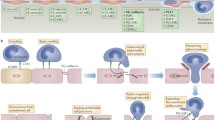Abstract
Lymphocytes are antigen specific cells whose effector function is acquired through complex differentiation pathways. This implies, firstly, antigen encounter and recognition at specific sites, and, subsequently, the transition from a naive to a memory/effector phenotype. Clonotypically expanded cells must then be capable of recirculating to the tissue where their effector function is needed. To this aim, defined receptor-counter receptor pairs are expressed on lymphocytes versus endothelial cells. Extravasation is therefore a key-process in this scenario. Indeed, different lymphocyte subsets display distinct recirculation patterns and capability to migrate into lymphoid and non-lymphoid tissues. As a general rule, naive lymphocytes preferentially migrate into secondary lymphoid organs, where all the requirements for effective antigen presentation and differentiation are available; in contrast, memory/effector lymphocytes preferentially migrate to peripheral tissues, such as skin and mucosa. We review here the molecular events that regulate leukocyte extravasation and the specific migration properties acquired by both naive and memory/effector lymphocytes under physiological and pathological conditions.
Similar content being viewed by others
Author information
Authors and Affiliations
Additional information
Received 17 December 1998; returned for revision 18 January 1999; accepted by M. J. Parnham 9 February 1999
Rights and permissions
About this article
Cite this article
Fabbri, M., Bianchi, E., Fumagalli, L. et al. Regulation of lymphocyte traffic by adhesion molecules. Inflamm. res. 48, 239–246 (1999). https://doi.org/10.1007/s000110050454
Published:
Issue Date:
DOI: https://doi.org/10.1007/s000110050454



